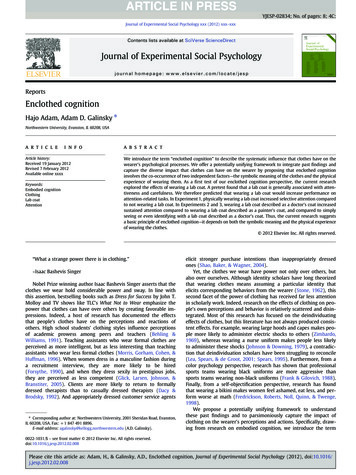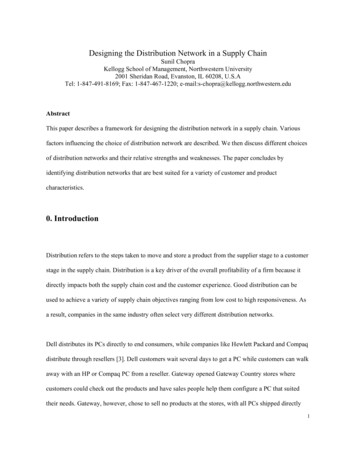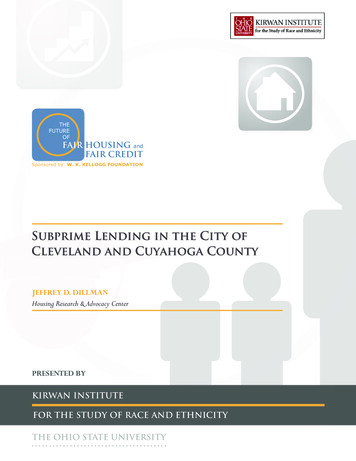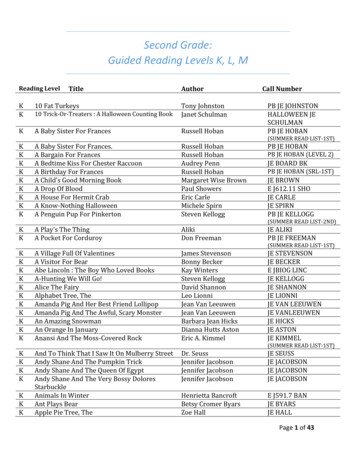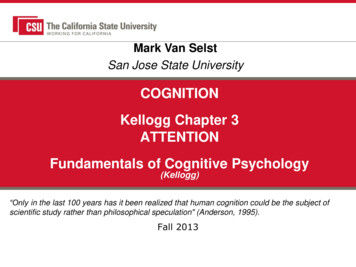
Transcription
Mark Van SelstSan Jose State UniversityCOGNITIONKellogg Chapter 3ATTENTIONFundamentals of Cognitive Psychology(Kellogg)“Only in the last 100 years has it been realized that human cognition could be the subject ofscientific study rather than philosophical speculation" (Anderson, 1995).Fall 2013
Cognition The collection of mental processes and activitiesused in perceiving, learning, remembering,thinking, understanding, and the act of usingthose processes. The study of how people perceive, learn,remember, and think about information.Kellogg Chapter 3AttentionVan Selst / Cognition
Assumptions & Foundations ofCognitive Psychology1. Mental Processes Exist Why say this? History of Behaviorism (struggle inthe mid-50s in proving that thought and mentalprocesses could be subject to scientific empiricalresearch)2. Firm Commitment to Objective Observational Methods Why say this? History of Introspection3. Information Processing Approach Why say this? This metatheory (overall approach)captures the philosophy of Cognitive PsychologyKellogg Chapter 3AttentionVan Selst / Cognition
Seven Themes of Cognition Attention TODAY Automatic vs. controlled processing the study of consciousness and control. (also TODAY) Data-Driven vs. Conceptually driven processing. processing driven by environment (data-driven) or existingknowledge (conceptually-driven) Representation how is information represented? same memory codes or different? Implicit vs. Explicit Memory aware vs unaware; can information for which you have noconscious awareness affect your behavior? (also TODAY) Metacognition our own perceived awareness of our own cognitive systems andcapabilities BrainKellogg Chapter 3AttentionVan Selst / Cognition
Cognition (History)Wilhelm Wundt (1832-1920) is regarded as the founder of psychology as a formal academicdiscipline. His method of inquiry was largely introspectionHermann Helmholtz had a particular interest in the speed of neural impulses. His research was oneof the first to demonstrate that it is possible to experiment on and measure a psychophysiologicalprocess. Helmholtz also developed the Young-Helmholtz theory of color vision.Hermann Ebbinghaus (1850-1909) was determined to study higher mental processes and examinethese processes neglected by Wundt. Ebbinghaus used the study of nonsense syllables to discoverthe fundamental laws of learning and developed the forgetting curve based on his “method ofsavings.”Frances Galton (1822-1911) believed in innate social worth determined human character not theenvironment (thus his advocacy for eugenics). He was interested in a small portion of thepopulation, the exceptional. Galton was the first to systematically apply statistical methods tocompare individuals. He invented the correlation coefficient, did substantial research about thedebate of Nature vs. Nurture, and invented the free-association technique.Edward Titchener (1867-1927) was a follower of Wundt. Titchener's view was that allconsciousness was capable of being reduced to three states: sensations, which are the basicelements of perception; images, which are the pictures formed in our minds to characterize what isperceived; and affections, which are the constituents of emotions. According to his theory ofmeaning, core referred to raw experiences such as sensations of light, sound, touch, and smell;context consisted of associations brought on by raw experiences. Context is what gives meaning tothe core. Titchener also believed that emotions are intensified feelings arising from sensationsinside the body.William James (1842-1910) wrote the first psychology textbook, Principles of Psychology. Theconcept of functionalism, the adaption of living persons to their environment, is expressed in James'psychology. James also contributed to the James-Lange theory (we feel an emotion because of theaction in which we choose to engage; e.g., we infer we are afraid because we run).Kellogg Chapter 3AttentionVan Selst / Cognition
Cognition (History)Edward Tolman was known for "his work that centered around demonstratingthat animals had both expectations and internal representations that guidedtheir behavior." (Galotti, 1994) He believed that rats used a cognitive map inorder to complete the maze instead of memorization.Wolfgang Kohler looked at the sudden solution that followed the quiet time"insight" and concluded that it was a typical property of problem solving.Frederick Bartlett was known for his study of memory. He placed his emphasison studies under natural conditions. Therefore, he rejected laboratoryresearch. He felt that past experiences helped reconstruct the material ableto be retrieved. He focused on information that was remembered and "misremembered". He saw memory as an active and often inaccurateprocess.Skinner, B. F. (1904-1995) is famous for his theory of operant conditioning. Hebelieved that behaviors and language were learned through reinforcement.He believed that behavioral changes resulted from responses of theindividual to environmental stimuli. He believed that the cognitive revolutionwas a backward, rather than a forward, step in the history of psychology.Kellogg Chapter 3AttentionVan Selst / Cognition
Cognition (History)Noam Chomsky’s review of Skinner's book on language (Verbal Behavior) isconsidered the famous turning point for Cognitive psychology. Chomsky, alinguist, argued that language cannot be explained through a stimulus responseprocess as Skinner claimed. Language is a way to express ideas, and the waythat these ideas are turned into language is a cognitive process. He showedthat language was much more complex than anyone previously believed andthat S-R accounts could not reasonably explain the complexities. Chomskyposits two types of structures: surface and deep structures.David Rumelhart & James McClelland argued that information processing happenssimultaneously (parallel) as opposed to serially (one at a time). Their ParallelDistributed Processing (PDP) Models suggest that many simple processingunits are responsible for sending excitatory and inhibitory signals to other units.By understanding these basic features, they believe that complex system can beexplained. The idea that processing involves interconnected elements and thereference to neural models, makes up their Connectionist Theory. (also seeNewell).George Miller is a professor at Princeton University. He studies informationprocessing and focuses his studies on the capacity of Short-term Memory(STM). His name is associated with the "Magic Number 7." This theory suggeststhat most people can remember 7 plus/minus 2 bits of information using theirSTM. Miller also found that recall of information is better when it is chunkedtogether.Kellogg Chapter 3AttentionVan Selst / Cognition
Attention(History and Definition)William James describes attention as “the takingpossession by the mind, in clear and vivid form,of one out of what may seem severalsimultaneous possible trains of thought Focalization [and] concentration ofconsciousness are of its essence” (pp. 403-404)This view largely describes what we refer to as“SELECTIVE ATTENTION”Kellogg Chapter 3AttentionVan Selst / Cognition
Attention Attention is the all important but poorly understoodprocess that can act to limit and affect our cognitiveprocessing. Attention refers to the concentration and focusing ofmental effort. It is: Selective Shiftable Divisable It is essential to most cognitive processing but onlypartially under our control. Is it a mechanism? a pool of resources? an epiphenomenon?Kellogg Chapter 3AttentionVan Selst / Cognition
AttentionAttention is the means by which we actively process alimited amount of the enormous amount of informationavailable through our senses, our stored memories, orother cognitive processes. It includes both Consciousand Unconscious processes. Conscious/Unconscious Attended/Unattended (no longer direct linkage – someactive attentional processing occurs without consciousawareness) Aware/Unaware Direct/Indirect Measures Kellogg Chapter 3AttentionVan Selst / Cognition
Functions of Attention(What does attention do?)Monitors our interaction with the environmentAssists linking past (memories) with present(sensations) to give continuity to our experiencesHelps us to control and plan future actionsKellogg Chapter 3AttentionVan Selst / Cognition
Functions of Attention(What does attention do?)1)2)Divided attentionVigilance and signal detection Vigilance: fatigue decreases detection of low probabilityevents Signal detection theory (Hit vs miss / False alarm vs correctrejection)3)Search (e.g., Target vs. distractor) Feature Integration Theory (Triesman) Guided Search (Wolfe) parallel stage (preselection) followed by serial4)Selective attention Filter Models ADHD illustrates failure to focus attentionKellogg Chapter 3AttentionVan Selst / Cognition
Filter Models vs.Capacity Models Filter models assume that attention operates as afilter that blocks the processing of some stimuliand allows processing of other stimuli Capacity models assume the agent selectsstimuli for additional processingKellogg Chapter 3AttentionVan Selst / Cognition
Filter Models(Early Selection) Broadbent (1958) put forward the first well-defined model of attention– a filter model with “early selection” – to account for results fromSHADOWING tasks and from DICHOTIC LISTENING tasks. Cherry (1953) used a shadowing task, in which one (auditory)message was to be repeated back out aloud (i.e., “shadowed”) whilea second auditory message was presented to the other ear. Results suggest that very little semantic information from the second(“non-attended”) message is absorbed. Physical changes to the to-be-unattended message were more likely tobe noticed (e.g., the insertion of a pure tone, changing the sex of thespeaker, changing the intensity of sound). Broadbent argues that the unattended auditory information receivesvery little processing because the message is filtered out based onperceptual characteristics.Kellogg Chapter 3AttentionVan Selst / Cognition
Filter Models(Early Selection) The Shadowing Task Listeners rarely noticed even when theunattended message was spoken in a foreignlanguage, reversed speech, or words repeated35 times.Kellogg Chapter 3AttentionVan Selst / Cognition
ShadowingShadowing: Messages are presented to both ears butsubject is told to attend to only one of the messages andrepeat it out loud. By and large subjects find it easy to perform this task Subjects can remember what was said on the attended channel. Some things subjects DON'T know about the unattendedchannel What words were spoken. The topic being discussed. The language of the voice. Some things subjects DO know about the unattended channel Whether it was a human voice or just noise Whether it was a male or female voice.Kellogg Chapter 3AttentionVan Selst / Cognition
DICHOTIC LISTENING Subjects tended to report all the informationcoming to one ear first then all the informationcoming to the other ear. If subjects are required to report digits in the orderof arrival they did better the more time there isbetween presentations.Kellogg Chapter 3AttentionVan Selst / Cognition
Early Selection(Broadbent)The basic claims of the model Sensory channels have an unlimited capacity There is a bottleneck allowing only one piece of information intoworking memory at a time. A selective filter allows in information from only one channel at a time. Information from unattended channel is completely blocked Time is required to switch from one channel to the nextEvidence for this “early selection” Bottleneck Model Explains the results of shadowing experiments. People can't repeat the message from the unattended ear (according toBroadbent) because the message was completely blocked. Broadbent (1958): Subject in dichotic listening task are presented withdigits simultaneously to each ear. They are asked to report all of thenumbers. Subjects tended to report one channel, then the other. If subjects are required to report digits in the order of arrival they do betterwhen there is more time between presentations.Kellogg Chapter 3AttentionVan Selst / Cognition
Evidence Against “EarlySelection” Bottleneck ModelsThe cocktail party effect (hearing your name)(Moray, 1959) INFORMATION MUST BE PROCESSED “LATE”(at least to a semantic level)Contextually generated semantic errors in shadowing(Treisman, 1960) INFORMATION MUST BE PROCESSED “LATE”(at least to a semantic level)Priming without Awareness INFORMATION MUST BE PROCESSED “LATE”(at least to a semantic level)Galvanic Skin Response studies. INFORMATION MUST BE PROCESSED “LATE”(at least to a semantic level)Kellogg Chapter 3AttentionVan Selst / Cognition
Evidence Against“EARLY” ModelsGalvanic skin response (GSR) is a measure of the electricalconductance of the skin and can be used to indicateincreased emotional arousal. During the training phase, subjects were given a mildelectric shock every time a certain word was presented. Dog, Hat, Beer, Couch ("Ow!"). Rabbit, Money, Cup, Couch("Ow!"), Pine, . After training, hearing the word "Couch", even without theelectric shock, produced a mild fear response (via ClassicalConditioning) which could be measured by GSR. Later on in a shadowing task the word "Couch" waspresented to the non-shadowed ear. Subjects showed an emotional response to the word eventhough they were not consciously aware of hearing it.Kellogg Chapter 3AttentionVan Selst / Cognition
Treisman'sAttenuation ModelThe Basic Claims of the Attentional Attenuation Model Messages differ in terms of "subjective loudness". Payingattention means increasing subjective loudness (turning up thedial) When shadowing, messages from the shadowed ear have ahigher subjective loudness than messages from the nonshadowed ear. Different concepts have different awareness thresholds – theseare the subjective loudness required for that concept to benoticed. Some concepts are permanently set with a low threshold forawareness (like one's name) and others depend on context.Kellogg Chapter 3AttentionVan Selst / Cognition
Attentional AttenuationModel (Triesman)Evidence supporting the attenuation model Your name has a permanently low threshold foractivation – It will be recognized even if it is part ofthe “non-attended” message (cocktail party effect). It explains contextual errors in shadowing.Concepts related to the message in the shadowedear temporarily have their recognition thresholdlowered. It explains the GSR experiments becauseunattended messages aren't completely blockedthey are just attenuated (such that the subject isnot conscious of them).Kellogg Chapter 3AttentionVan Selst / Cognition
Deutsch & Deutsch’s “Late Selection”model and Norman’s Pertinence ModelDeutsch and Deutsch suggested that both channels of information arefully processed but are quickly forgotten (unless attended to – e.g., ifthey hold personal pertinence to the individual).In shadowing experiments, the participant is asked to repeat a certainmessage, that would create the personal significance needed forretention.Norman elaborated on Deutsch and Deutsch's model by suggestingthat selection is determined not only by the pertinence of the sensoryinput but also the strength of the input.Kellogg Chapter 3AttentionVan Selst / Cognition
Early vs. Late SelectionModelsTriesman and Broadbent posit that attention serves to determine thenature of the information that gets into Short Term Memory. They are“Early Selection” Models because they assume that attentionalselection occurs early, before information enters Short Term Memory.Late Selection Models (Norman, 1968) assume that all information getsinto Short Term Memory but that information which isn't attended to israpidly forgotten (within a fraction of a second). They are called LateSelection Models because the selection doesn't occur until fairly late inthe process, when information is already in Short Term Memory.Early Selection models treat Short Term Memory as a small box intowhich only a few (7 /- 2) items can fit. Attention picks items to go intothat small box.Late selection models treat Short Term Memory as large box into whichmany items can fit but in which items disappear quite rapidly unlessthey are attended to.Kellogg Chapter 3AttentionVan Selst / Cognition
Kellogg Chapter 3AttentionVan Selst / Cognition
Capacity Theories Kahneman (1973) introduced the notion of“capacity” with “attention” as a mental resourcethat could be shared or distributed acrossmultiple tasks. Johnston & Heinz (1978) developed the“multimode model of attention” to reflect theincreasing mental costs for selection at variousstages of processingKellogg Chapter 3AttentionVan Selst / Cognition
Multi-Mode Model of Attention(Johnston & Heinz, 1978)Cost on Secondary Task duringDichotic Listening (Selection)Cost (RT2)200150100500123Number of Incoming Messagesd(meaning)Kellogg Chapter 3Attentiond(physical)Van Selst / Cognitiond(both)
Multiple Resources Johnston & Heinz (1978) “mulitmode model ofattention” says attention can operate at anumber of different stages Wickens (1980) proposes a multiple resourcemodel with perceptual, cognitive, and outputrelated domains each separated across the taskdefined verbal and spatial coding required. Hetreats each “bin” as a separate pool of resourcesthat a task might draw on (and/or be constrainedby limitations encountered).Kellogg Chapter 3AttentionVan Selst / Cognition
ConsciousnessConsciousnessone’s awareness of stimuli and events inside andoutside of one’s self;An awareness of the sensations, thoughts, &feelings that one is attending to at a givenmoment;Awareness of one’s surroundings and of what’son one’s mind at a given moment (per text)
Wakefulness (arousal) vs. AwarenessLucid DreamingMinimally ConsciousMinimallyConscious StateVegetativePersistentVegetativeStateVan Selst(Winter 2009)
Wakefulness &AwarenessGlasgow Coma ScaleWakefulness: degree of alertness (awakevs. asleep)Awareness: monitoring of information fromenvironment and from one’s ownthoughtsVegetative State: minimal consciousness;eyes may be open but person isotherwise non-responsiveComa: eyes are closed and person isunresponsive and unarousable
ConsciousnessIllustrations of “UNCONSCIOUS” Processing:Subliminal Messages? – A stimulus that is presented below the threshold forawareness Greenwald “unconscious self-help” tapes perceived effectiveness. Greenwald/Merikle “perception without awareness”?Mere Exposure – the more often you see a stimulus, the more you come to like it. Form of influence w/o awarenessPriming – Tendency for a recently presented word or concept to facilitateresponses in a subsequent situation. Quicker to read “doctor” after “nurse”presented than after “apple”Prosopagnosia – inability to recognize familiar faces, although brain activityincreases despite non-recognitionBlindsight – damage to visual cortex resulting in the encoding of visual info withoutawarenessTip-of-the-Toungue (ToT) Phenomena – some information is present butunavailable
ConsciousnessWhat constitutes “Subliminal” (belowthreshold) Perception? Limen: “limit” or threshold subliminal below threshold. Which Threshold? Problem of declaring an absoluteabsence of conscious awareness
ConsciousnessSubliminal?Cards down the hall until “cannot identify it” subjectively; but is this truly“unconscious” despite subjective reports that there is no “conscious” experience ofidentification.“nulling consciousness”: required if you are to claim that all information presented isavailable ONLY to the unconscious (this is a MAJOR problem for “absolutethreshold” of consciousness type arguments (e.g., “subliminal perception” isperception below the threshold of consciousness – and thus we should be unawareof it at ANY conscious level).Multiple-choice versus identificationExplicit vs. ImplicitTask focused versus “other questions” (e.g., which brighter?)Processes in opposition:place “conscious” knowledge such that it operates in the opposite direction as the“unconscious” knowledge. For instance, when completing a STEM-COMPLETIONtask (e.g., D K), the instruction to include items from the previous memory listversus instructions to exclude the items from the previous memory lists.
Unconscious Influence?Despite not beingaware of the wordsthat they “saw”, thoseexposed to positivewords were happierand those exposed tonegative wordsreported beingsadder. This indicatesthat moods can beinfluenced withoutawareness
ConsciousnessAttention: a state of awareness consisting of thesensations, thoughts, & feelings that one isfocused on in a given IOUSIMPLICITUNATTENDED
ConsciousnessSelective attention Ability to focus awareness on a single stimulus to theexclusion of other stimuli. Ability to focus awareness on specific features in theenvironment while ignoring others (text)Dichotic listening task (analogy) Unable to follow/remember competing conversation.Cocktail party effect Ability to attend selectively to one person’s speech amongcompeting conversations but highly relevant stimuli still detectedFailures of selective attentionStroop Interference
Selective AttentionRead the “black words” onlyIn performing an experiment like this one on man attentioncar it house is boy critically hat important shoe that candythe old material horse that tree is pen being phone readcow by the hot subject tape for pin the stand relevantview task sky be red cohesive man and car grammaticallyhouse complete boy but hat without shoe either candybeing horse so tree easy that phone full cow attention ishot not tape required pin in stand order view to sky readred it nor too difficultWhen people do this type of task they do not effectivelyremember the red words
Selective AttentionWhat happens to unattended information?http://www.youtube.com/watch?v vJG698U2Mvo
Failures of Selective AttentionIronic ProcessesThe harder ones tries to control a thought or behavior, theless likely one is to succeed, especially if distracted,tired, or under stress.Examples:1) Do not think about a white bear2) Subjects instructed to control a pendulum moved itmore than those not instructed.3) Golfers were more likely to overshoot a putt when tryingnot to do so.Van Selst (Winter 2009)
Automatic vs. Controlled Processing(Posner & Snyder, 1975, 1975)CONTROLLED With intent (only) Aware (Conscious) Attention demanding Slow (1 second ) Characteristic of novel orunpracticed tasks withmany variable features Requires analysis orsynthesis of information Usually difficult tasksKellogg Chapter 3AttentionAUTOMATIC without intention Not open to awareness Low attentional requirement Rapid Characteristic of familiarand highly practiced tasks(automaticity develops withpractice – e.g., Bryan &Harter, 1899 [telegraphoperators]) Minimal analysis orsynthesis of information Typically fairly easy tasksVan Selst / Cognition
Automatic vs.Controlled Processing Difference between automatic and controlledprocessing can be illustrated by Priming (e.g.,Neely) Automaticity can be bad Airplane (de-icer “off”. yes [though should be “on”for icy conditions]) Errors .Kellogg Chapter 3AttentionVan Selst / Cognition
ErrorsMistakes: errors in choosing an objective or specifying the means toachieve the objective (intentional, controlled processes)Slips: errors in carrying out intended actions (often involve automaticprocessing)Types of slipsCapture error: failure to depart from automatic routineOmission: interruption in routine leads to skipping one or more steps onresumptionPerseveration: repeating an already completed processDescription: correct action on the wrong object (due to internaldescription of intended action)Data-Driven error: incoming sensory input overrides intended action(e.g., dialing numbers heard in the environment rather than intendedphone number)Associative-Activation error: strong associations lead to wrongautomatic behavior (e.g., wrong name, “come in” to doorbell, etc.)Loss-of-activation error: “what am I doing here after entering a room” Kellogg Chapter 3AttentionVan Selst / Cognition
Neurological Evidence(visual attention) Demonstrable “fine-tuning” of visual receptivefields (neural responses) occur via the thalamus(specifically the Pulvinar Thalamic Nucleus) Pulvinar Thalamic Nucleus: reads out newinformation – other areas control engage,moving, and disengage functions – failure of thissystem produces ‘spatial neglect’ (failure to moveattention)Kellogg Chapter 3AttentionVan Selst / Cognition
Neurological Evidence(Executive Attention)Executive Attention refers to a supervisory attentionalsystem (based around the function of the anteriorcingulate gyrus [frontal lobe]) that inhibits inappropriatemental representations or responses and serves to activeappropriate ones.Executive Attention is needed for: (Norman & Shallice, 1986) planning and making decisions;correcting errors;the required response is novel or not well-learned;conditions are cognitively demanding or dangerous; or,an automatic response must be inhibited and overcomeKellogg Chapter 3AttentionVan Selst / Cognition
Neurological Evidence(the “binding problem”)The Binding Problem is that features and stimulicharacteristics for a single object are representedacross distributed brain regions. These aspectsneed to be integrated into a cohesive percept.Binding requires attention. Failures of attentionaround binding produce INATTENTIONALBLINDNESS (when covert attention elsewhere inthe display) and the ATTENTIONAL BLINK(when attention is occupied with encoding a priorstimulus).Kellogg Chapter 3AttentionVan Selst / Cognition
Kellogg Chapter 3AttentionVan Selst / Cognition
Assignment 3The Binding ProblemDefine the binding problem, as it is described in the text.Your assignment is to discuss the role of the binding problem as it relates toinattentional blindness leading to the attentional blink as well as the largerproblem of producing coherent phenomenological percepts despite stimuluscharacteristics being represented in widely disparate parts of the brain(readings on consciousness and in particular the work of Baars may bepursued by the advanced student).You must include at least one definition of what the binding problem is, at leastone definition of the attentional blink, at least one definition of inattentionalblindness and, based on the technical readings, provide some insight intohow cognitive psychologists have endeavored to understand the bindingproblem.Note that I anticipate and understand that there will be parts of the additionalreadings (those beyond the textbook that you will encounter in your researchto best answer this question) that you will not fully understand. Obviously, Iexpect that you will check with a number of secondary sources (including thetextbook) to help clarify the concepts underlying the binding problem. Youshould cite these sources (preferably in APA style) where appropriate.Kellogg Chapter 3AttentionVan Selst / Cognition
“Where” versus “What”pathwaysKellogg Chapter 3AttentionVan Selst / Cognition
Attention"Everyone knows what attention is. It is the takingpossession by the mind in clear and vivid form, ofone out of what seem several simultaneouslypossible objects or trains of thought.It implieswithdrawal from some things in order to dealeffectively with others, and is a condition whichhas a real opposite in the confused, dazed,scatterbrained state." (p. 403)- William James (1892)Kellogg Chapter 3AttentionVan Selst / Cognition
Terminology AttentionSelective AttentionDivided AttentionShadowingEarly SelectionAttenuationPrimingMental EffortStroop EffectAutomatic ProcessControlled Process Central BottleneckOrientingSpatial NeglectAlertingExecutive ActionAnterior Cingulate GyrusFeature Integration TheoryBinding ProblemInattentional BlindnessAttentional BlinkSubliminal Perception
Copyright 2013 / Van Selstwww.calstate.eduwww.sjsu.edu/psych
COGNITION Kellogg Chapter 3 ATTENTION Fundamentals of Cognitive Psychology (Kellogg) Fall 2013 Mark Van Selst San Jose State University “Only in the last 100 years has it been realized that human cognition could be the subject of scientific study rather than phil

